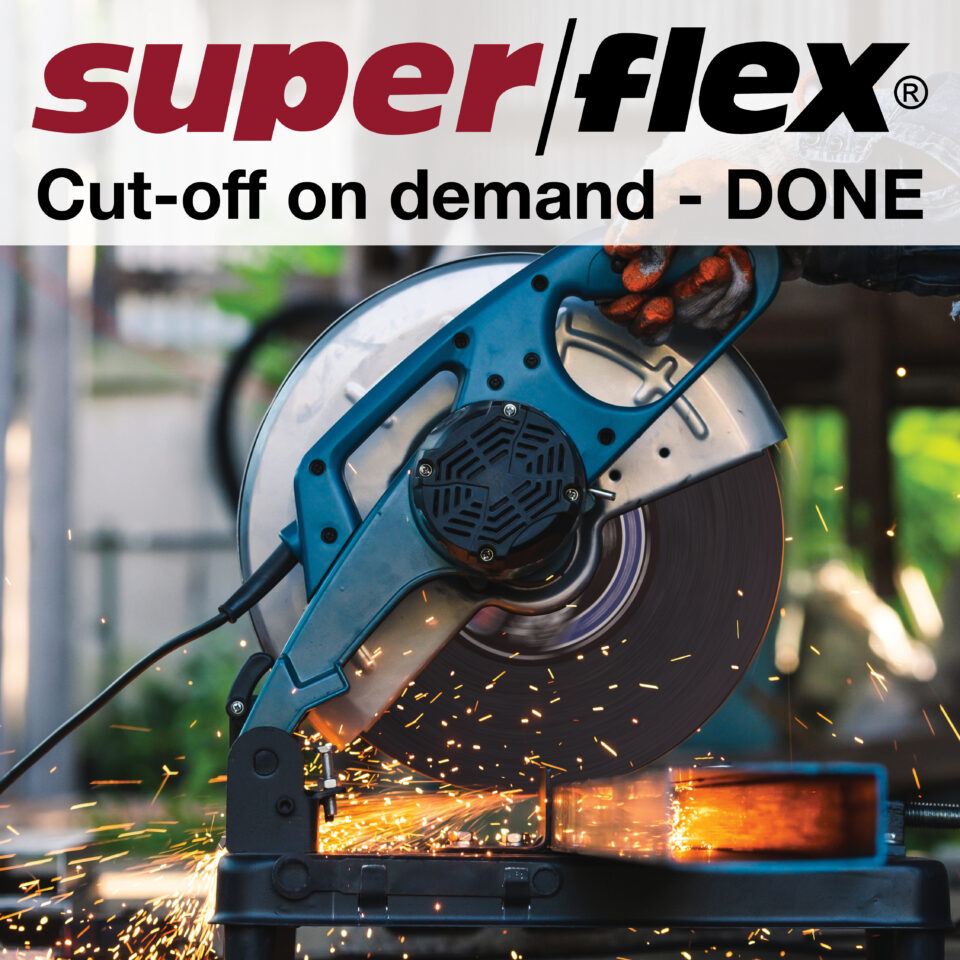Abrasive Cut-Off Disc by Superflex
When it comes to the cutting of tubing, structural steel, and bar stock, abrasive cut-off discs, metal circular bandsaws and oxy-acetylene cutting torches are among the most popular methods used however it is to be noted that each have their own benefits and disadvantages.
Although the metal saw continues to be the preferred cutting-off method for large cross-sections like steel beams and plates, the abrasive cut-off disc, offers much greater speed and economy compared to a steel circular or power saw blade on a host of small to medium sized materials. Studies have indicated that the abrasive cut-off disc will generally outperform the metal saw and cutting torch with cuts being made with a diameter of 50mm to 150mm.
Apart from being the most economical solution for this application, using an abrasive cut-off disc also increases production due to much more cutting points present on the cut-off disc compared to circular steel or power saw blades. These cutting points are a multitude of sharp abrasive cutting edges, commonly referred to as cutting teeth on the disc’s face that cut through the workpiece like teeth of a saw as the disc rotates at a high speed. Formally, abrasive cut-off discs were only used in applications where the material was either too hard or too delicate for a steel saw. Nowadays, they are being recognized as an efficient and high production tool capable of cutting all types of metals, including steel, brass, copper, glass, ceramics, carbides, and most composite materials.
However, when it comes to dry cutting, two factors should be considered – one being discoloration and the other burning. Discoloration occurs when excessive heat is generated in cutting and can be eliminated by improving the cutting action with a different disc specification or the use of a rough sided disc. Discoloration is particularly problematic when machining operations follow the cutting off process as it is referred to surface or skin-hardening which affects machinability.
While discoloration can be managed, burring cannot be eliminated in dry cutting without sacrificing disc life. Finer grit discs produce a lighter burr which is easily removed but, generally, they have a higher rate of longevity than the coarser grit discs.
When it comes to the longevity of abrasive cut-off discs vs disc feed or pressure, it needs to be noted that longevity of an abrasive disc is dependent on the rate at which the abrasive grains are dulled and ultimately released by the bonding system to produce new sharp edges. When a low rate of disc feed is used, the pressure is correspondingly light. For the abrasive grains to cut and remove the metal as chips (sparks), a reasonable amount of pressure is required. If this pressure, due to the low rate of disc feed, is too light, the abrasive grains will rub rather than cut this will cause excessive heat build-up and softening of the bond will follow, causing the disc to wear prematurely.
Organic or resin bond refers to the substance that holds the abrasive grains in place. The bond is also often referred to as the grade, or hardness of a disc, which does not signify the hardness of the abrasive grains themselves but the hardness of the bond holding them in place.
Abrasive cut-off discs are produced in two main minerals, also known as abrasive grain types. Alumina Oxide grain which stays sharper for longer and is mainly used for applications on high tensile strength steel and other metals, while Silicon Carbide grain is more suited to applications on Non-Ferrous metals with lower tensile strength such as carbons, brass, and copper.
Abrasive cut-off discs are manufactured with either rough or smooth sides. Smooth sided discs are used mostly in general applications where the material does not tend to load the cutting disc and when cutting is the preliminary operation. Typical materials cut with this type of disc will include hard steels, pipe, ceramic, copper rod, and tubing. Whenever the material must be free of burrs and or burn, or where a material tends to load or bind the disc, a rough sided disc is recommended. Typical materials that will require a rough sided discs would include soft materials like brass, steel cable, and soft steel.
All Superflex abrasive cut-off discs are reinforced and commonly used throughout the foundry and construction industries because of its very high resistance to breakage combined with fast cutting action and low rate of wear. The cut-off disc owes its strength to the built-in reinforcement.
As a proud and local South African manufacturer, Grinding Techniques is continually committed to the development of these products and our Superflex range carries a variety of abrasive cut-off discs for multiple applications on both Ferrous-and Non-Ferrous metals, each with its own advantage dependent on the dimensions of the material to be cut.
It is of utmost importance to select the correct specification cut-off disc for the specific job and application at hand. With our Research and Development team, cut-off discs are continually tested and evaluated to ensure optimum performance with the latest technology, whilst our Business Development Team is ready to assist in specifying the correct type, grain, and grade of any cut-off disc for your application.
For more information, contact us: +27 11 271 6400 | info@grindtech.com | www.grindtech.com



